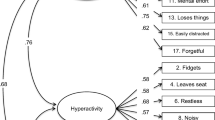Abstract
The construct of dysphoria has been described inconsistently across a broad range of psychopathology. The term has been used to refer to an irritable state of discontent, but is also thought to incorporate anger, resentment and nonspecific symptoms associated with anxiety and depression, such as tension and unhappiness. The Nepean Dysphoria Scale has been developed to allow assessment of dysphoria, but its factor structure has not yet been investigated in clinical samples. We aimed to determine the latent structure of dysphoria as reflected by the Nepean Dysphoria Scale, using a clinical sample. Adults (N = 206) seeking treatment at a range of mental health services were administered the Nepean Dysphoria Scale. Four putative factor structures were investigated using confirmatory factor analysis: a single-factor model, a hierarchical model, a bifactor model and a four-factor model as identified in previous studies. No model fit the data except for a four-factor model when a revised 22-item version of the original 24-item scale was investigated. A four-factor structure similar to that identified in non-clinical samples was supported, albeit following the removal of two items. The Nepean Dysphoria Scale appears to have utility for the assessment of dysphoria in routine clinical settings.
Similar content being viewed by others
References
Starcevic V, Rossi Monti M, D’Agostino A, Berle D. Will DSM-5 make us feel dysphoric? Conceptualisation(s) of dysphoria in the most recent classification of mental disorders. Aust N Z J Psychiatry. 2013;47:954–5.
Berle D, Moulds ML. Emotional reasoning processes and dysphoric mood: cross-sectional and prospective relationships. PLoS One. 2013;8(6):e67359.
Ellis AJ, Beevers CG, Wells TT. Emotional dysregulation in dysphoria: support for emotion context insensitivity in response to performance-based feedback. J Behav Ther Exp Psychiatry. 2009;40:443–54.
Teasdale JD, Cox SG. Dysphoria: self-devaluative and affective components in recovered depressed patients and never depressed controls. Psychol Med. 2001;31:1311–6.
Beek TF, Cohen-Kettenis PT, Kreukels BPC. Gender incongruence/gender dysphoria and its classification history. Int Rev Psychiatry. 2016;28:5–12.
Simms LJ, Watson D, Doebbeling BN. Confirmatory factor analyses of posttraumatic stress symptoms in deployed and nondeployed veterans of the Gulf war. J Abnorm Psychol. 2002;111:637–47.
Rossi Monti M, D'Agostino A. Borderline personality disorder from a psychopathological-dynamic perspective. J Psychopathol. 2014;20:451–61.
Musalek M, Griengl H, Hobl B, Sachs G, Zoghlami A. Dysphoria from a transnosological perspective. Psychopathology. 2000;33:209–14.
Starcevic V. Dysphoric about dysphoria: towards a greater conceptual clarity of the term. Australas Psychiatry. 2007;15:9–13.
Starcevic V, Berle D, Viswasam K, Hannan A, Milicevic D, Brakoulias V, et al. Specificity of the relationships between dysphoria and related constructs in an outpatient sample. Psychiatry Q. 2015;86:459–69.
Erbes CR, Meis LA, Polusny MA, Compton JS, Wadsworth SM. An examination of PTSD symptoms and relationship functioning in US soldiers of the Iraq war over time. J Trauma Stress. 2012;25:187–90.
Berle D, Starcevic V. Preliminary validation of the Nepean dysphoria scale. Australas Psychiatry. 2012;20:322–6.
D’Agostino A, Manganelli E, Aportone A, Rossi Monti M, Starcevic V. Development, cross-cultural adaptation process and preliminary validation of the Italian version of the Nepean dysphoria scale. J Psychopathol. 2016;22:149–56.
Caspi A, Houts RM, Belsky DW, Goldman-Mellor SJ, Harrington H, Israel S, et al. The p factor: one general psychopathology factor in the structure of psychiatric disorders? Clin Psychol Sci. 2014;2:119–37.
Rosseel Y. Lavaan: an R package for structural equation modeling. J Stat Softw. 2012;48:1–36.
Beauducel A, Herzberg PY. On the performance of maximum likelihood versus means and variance adjusted weighted least squares estimation in CFA. Struct Equ Model. 2006;13:186–203.
Hu L-I, Bentler PM. Cutoff criteria for fit indexes in covariance structure analysis: conventional criteria versus new alternatives. Struct Equ Model. 1999;6:1–55.
Gootzeit J, Markon K. Factors of PTSD: differential specificity and external correlates. Clin Psychol Rev. 2011;31:993–1003.
Acknowledgements
Dominic Hilbrink, Laura Hardaker, Clare Russell-Williams, Rachel Kiely and all of the allied health staff at St John of God Health Care Richmond Hospital are thanked for their assistance with participant recruitment. Brian Skepper and Erin Dale of the Nepean Anxiety Disorders Clinic also assisted with participant recruitment.
Funding
This research was supported by a Defence Health Foundation Grant awarded to the first and last authors (DB & ZS).
Author information
Authors and Affiliations
Corresponding author
Ethics declarations
Human Participants and Animal Studies
All procedures involving human participants were in accordance with the ethical standards of the institutional and/or national research committee and with the 1964 Helsinki declaration.
Ethical Approval
The study was approved by the Nepean Blue Mountains Local Health District Human Research Ethics Committee (Ref 07/068–07/NEPEAN/14) and the St John of God Health Care Human Research Ethics Committee (Ref: 839).
Conflict of Interest
The authors declare that they have no conflict of interest.
Appendix 1
Appendix 1
Rights and permissions
About this article
Cite this article
Berle, D., Starcevic, V., Viswasam, K. et al. Confirmatory Factor Analysis of the Nepean Dysphoria Scale in a Clinical Sample. Psychiatr Q 89, 621–629 (2018). https://doi.org/10.1007/s11126-018-9564-9
Published:
Issue Date:
DOI: https://doi.org/10.1007/s11126-018-9564-9




